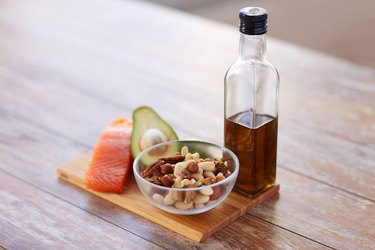
Fat is a healthy macronutrient that assists with vitamin absorption, satiation, meal enjoyment, organ health and healthy skin and hair. Eating too much fat can cause you to take in too many calories and gain weight, though. Between 25 and 35 percent of your daily calorie intake should come from fats.
Limit your intake of saturated fat, found in meat and full-fat dairy, to 5 to 6 percent of total calories since it is more likely to contribute to health problems, including heart disease. The rest of your fat intake should come from unsaturated fats found in foods such as fatty fish, olive oil, avocado and nuts. When you know your total calorie intake and how many grams of fat you've consumed, the percentage of fat calories is fairly easy to figure out.
Video of the Day
Video of the Day
Calories in Macronutrients
Nutrients you eat and need in relatively large quantities are called macronutrients. Fat, along with protein and carbohydrates, are the three macronutrients your body requires daily for good health. Protein and carbohydrates contain 4 calories per gram, while fat contains 9 calories per gram. So, if you ate a meal with 20 grams of fat, you consumed 180 calories worth of fat.
Figuring Percentages of Fat Calories in Daily Food Intake
To figure the percentage of calories you consume from fat in any given day, you must know your total calorie intake and the number of grams of fat you've eaten. Then multiply the fat grams by 9 to determine your total intake of fat calories that day. Divide the total intake of fat calories by your daily calorie intake to come up with a decimal that represents the percentage of fat calories you've eaten.
For example, if you've consumed 50 grams of fat over the course of three meals and two snacks, you've had a total of 450 fat calories because 50 grams x 9 calories/gram = 450 calories. If your meals and snacks for the day totaled 2,000 calories, divide 450 by 2,000 to get 0.225 -- which means you got 22.5 percent of your daily calories from fat.
Computing Intake of Saturated Fat
To determine if you're eating too much saturated fat, follow a similar equation, but substitute saturated fat grams for total fat grams. In the same example in which you've eaten 2,000 calories, 50 grams of which were fat, say that 10 of those 50 grams were saturated. Multiply 10 by 9 -- the calories in a gram of any type of fat -- to get 90. Divide 90 by 2,000 to total 0.045 -- or about 4 1/2 percent of daily calories from saturated fat. This intake represents a healthy level.
The grams of saturated fat in a serving of food are readily found on the food label, food producers' websites or on a nutrition information website, such as the one provided by the U.S. Department of Agriculture.
Focus on the Healthy Fats
"Low-fat" wrongly became synonymous with "healthy" in the 1980s and 90s. Many foods had fat stripped away, only to be replaced with added sugar. "Low-fat" or "nonfat" doesn't mean low-calorie, however, and eating these foods in abundance can cause weight gain.
While you shouldn't load up on fried foods, buttery croissants and barbecue brisket, eating a moderate amount of unsaturated fats -- such as olive oil, avocado, salmon and walnuts -- enriches your nutrient intake and may help protect you from chronic disease.
The one type of fat you should avoid whenever possible is man-made trans fats. Once found in margarine, commercial fried foods and some snacks, trans fat causes an especially fast buildup of arterial plaque, a major risk factor for coronary heart disease. Some manufacturers still use the fat in foods such as tub frosting, biscuits and microwave popcorn. It is listed as trans fats on the nutrition facts label or as "partially hydrogenated" oil on the ingredient list. Because the Food and Drug Administration has determined that trans fats are not safe, look for them to slowly disappear from the food supply.
- American Heart Association: Know Your Fats
- McKinley Health Center: Macronutrients: the Importance of Carbohydrate, Protein, and Fat
- Harvard School of Public Health: Low-Fat Diet Not a Cure All
- U.S. Food and Drug Administration: FDA Cuts Trans Fat in Processed Foods
- USDA: National Nutrient Database for Standard Reference